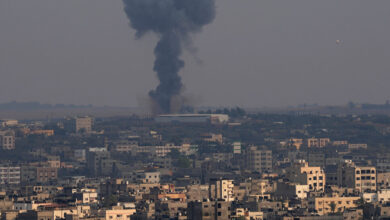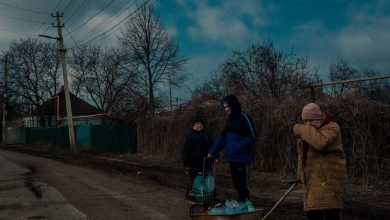These Are the Cities in Ukraine Facing Russian Attacks

Blackened and bombed-out apartment towers. Families huddled together in subway stations. Downtown streets made silent, with shuttered cafes and nightclubs.
The images emerging from Russia’s invasion of Ukraine are reminders of what wars often prove: cities are both key strategic targets and the places that bear the greatest costs of conflict.
Towns and villages in the path of the Russian advance have also been devastated. But it is the cities, which were home to about two-thirds of Ukraine’s population of 44 million people before the invasion, that are the focus of the Russian assault.
Now from Kharkiv and Kyiv in the north to Mariupol in the south, many women and children have fled, and urban neighborhoods are becoming battlegrounds. Businesses, homes, schools, cultural institutions and historical buildings are all being threatened with destruction.
Here are the major cities in Ukraine that are under attack — and what they stand to lose. Updates on the status of Russia’s incursion will be added regularly.
Kharkiv: Undergoing fierce fighting
Steeped in art, literature and Romanticism, Kharkiv is a major city close to the Russian border, making it a key military target.
Roughly 20 miles from the northwest border between Ukraine and Russia sits Kharkiv, a city whose place in the Kremlin’s version of history made it an early target of Russian attacks.
Russian bombs have devastated the city’s downtown core,including Kharkiv National University. On March 4, the city was still under Ukrainian control, despite the bombardment.
President Vladimir V. Putin of Russia has long maintained that the Kharkiv’s history provides proof that Ukraine is an appendage of Russia. During and after World War I, the city served as the first capital of the Ukrainian Soviet Socialist Republic, a largely Moscow-controlled entity set up in opposition to the Ukrainian People’s Republic in Kyiv, which declared an independent Ukrainian state.
With 1.4 million residents, Kharkiv is Ukraine’s second largest city and a transportation hub — a key stop on a major rail corridor, with highways connecting western Ukraine and Russia’s highway system.
Kharkiv is home to one of the first contemporary art galleries in the country, which opened its doors in 1996, and features other culturally significant venues.
It is famous for the poets and writers of the Kharkiv Romantic School, including Taras Shevchenko, memorialized in a city garden monument, one of many sculptures and landmarks to cultural figures.
Kherson: Fell to the Russian military
The shipbuilding city is an important node for access to the Black Sea.
The port city of Kherson is in the south of Ukraine, on the Dnieper River near the Black Sea. It sits about 340 miles from the capital of Kyiv.
The city is a major hub for shipbuilding and provides access to Ukraine’s southern coastline for invading Russian forces.
Kherson was a training ground for naval cadets, and is home to major technical colleges supporting local industries, including agriculture, cotton textiles and engineering.
The city has also been a backdrop for important archaeological excavations, unearthing evidence of ancient settlements through the discoveries of burial mounds, royal tombs and other artifacts from the third and fourth century.
Now, the city is unrecognizable, said its mayor, Igor Kolykhaev. Days of intense fighting left as many as 300 Ukrainian civilians and fighters dead, he said. Power, water and gas services were damaged during the heavy shelling of the city of about 300,000 people.
The fall of the city put the Russian military in view of western Ukraine, toward the city of Odessa.
For a few hours on March 5, protesters gathered in Liberty Square in the city center, the most visible example so far of resistance to Russian occupation.
Kyiv: Russians closing in, meeting strong resistance
Once a destination among partygoers and tourists admiring Ukrainian baroque architecture, the country’s capital is the war’s most important territorial and political target.
Just a few months ago, Kyiv was a well-kept secret among pandemic partygoers, the scene of a vibrant underground nightlife and a popular draw among tourists breezing through Eastern Europe’s metropolises.
Now, the Ukrainian capital is under siege.
A city of 2.8 million before the war, Kyiv is the political, cultural and industrial center of the country. The city has several important historical and architectural monuments including the cathedral of St. Sophia, which is now a museum. Built in the 11th century, it is considered one of the world’s finest examples of early Rus’-Byzantine ecclesiastical architecture.
Kyiv is the most important territorial target for Russia and is being encircled by Russian troops.A 40-mile long column of Russian armored and military vehicles has been lined up to the northwest of the city. From there, Russian troops are firing rockets into the city.
On March 1, Kyiv’s main radio and TV tower was hit by a projectile. There were other explosions nearby, killing at least five people. As of March 4, most of the fighting was still taking place in towns outside the city.
Electricity and communications continue to work, for the most part, along with train lines, but schools and most businesses have closed.
Tens of thousands of people have fled Kyiv, heading west to Lviv and then on to Poland or other destinations in Europe, even as refugees from areas with pitched battles to the west have more recently started to pour in.
Mariupol: Under heavy shelling
Strategically located between a separatist enclave and Crimea, Mariupol’s coastline, once a major tourist draw, is a key target for Russian forces.
Mariupol sits along the world’s shallowest sea, the Azov. Before the war, its coastline provided a backdrop for tourists — and for earlier tensions between Ukraine and Russia.
It is between the Donbas region, controlled by Russian-backed separatists, and the Crimean Peninsula, which Russia annexed in 2014. Since it is also less than 40 miles from the Russian border, Mariupol has been hit hard and early, suffering more than many other Ukrainian cities in the first phase of Russia’s invasion.
Heavy Russian bombardment has cut off power, water and heat.Russia and Ukraine agreed to a limited “cease-fire” on Saturday morning only to see it collapse within hours under Russian shelling.
If Russia seizes the area, Ukraine will lose key industrial infrastructure and Russia will gain a clear path for President Putin to take control of the Sea of Azov, a thruway for Ukraine’s agricultural products and other exports such as coal and steel.
In 1948, when the Soviet Union governed Ukraine, the city was renamed for Andrey Aleksandrovich Zhdanov, a high-ranking Communist Party functionary who had been born there. The city’s earlier name, Mariupol, was restored in 1989 as Soviet rule faded near the end of the Cold War.
Now many of the city’s buildings bear the burn marks of Russian artillery.
Michael Schwirtz contributed reporting from Odessa, Richard Pérez-Peña from Los Angeles, Andrew Higgins from Warsaw, Damien Cave from Sydney and Vjosa Isai from Toronto.





